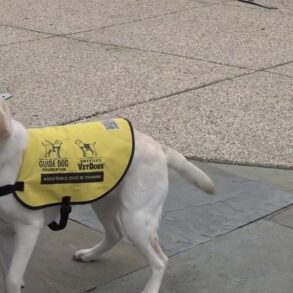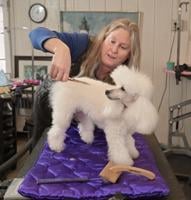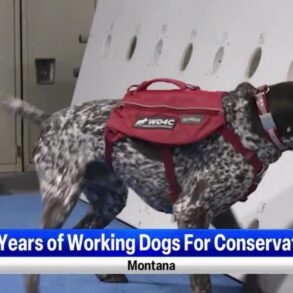
QUICK SUMMARY: More dental offices today are using on-site emotional support and therapy dogs to help relieve patients’ dental anxiety and to even boost patients’ feelings of well-being. Read about the successful introduction of an emotional support dog at a Sacramento dental practice. We explain the difference between service, therapy and emotional support animals and encourage dentists review important considerations before bringing an animal to the practice.
When the entry bell rings at D2O Dental in Sacramento, Ruby, a 5-year-old goldendoodle, gets up from her corner and gently lopes over to greet the incoming patient, often with a plush toy in her mouth.
Ruby, with her bushy eyebrows and wavy cream-colored coat, is in the office three to four days a week, whenever her guardian, practice owner Ed Wiggins, DDS, is working. She is not there to ask for treats or play fetch, though she won’t say no to chin rubs. Her main job is to make patients feel more at ease, but she often brings them something closer to joy.
‘She senses what’s going on here — she wants to help out’
“At home, she’s high energy, but she turns into a completely different animal in the office,” Dr. Wiggins said. “In the office, she won’t even wag her tail fast. She senses what’s going on here — that this is a health care facility and people are coming in for teeth and gum care. She wants to help out.”
Ruby helps by sitting down in the waiting room and letting patients pet her. When one patient is satisfied, Ruby moves on to the next patient. Once all patients are smiling and their nerves calmed — or if patients are otherwise occupied — Ruby returns to the comfortable corner in Wiggins’ private office to “chill out,” as the dentist puts it.
“She likes meeting new people,” said Wiggins, who opened D2O in Dental in 2010 and started bringing Ruby to the office last September.
“When at home, if she knows it’s a day she’s coming into the office, she gets all excited. It’s her favorite place to go. I think it gives her a sense of purpose. She really looks at this as her job.”
Relieving a potential barrier to care – dental anxiety
More dental offices today are using on-site emotional support and therapy dogs to help relieve patients’ anxiety and even boost patients’ feelings of well-being. Other dental practices are considering using them. Research has shown the animals can lower blood pressure, making them a potentially effective alternative to the use of sedative medications for patients with mild to moderate anxiety.
“Impact of the Use of Therapy Dogs in the Dental Office: A Review of Reviews,” published in the fall 2023 edition of the California Dental Hygienist Association Journal, concluded that therapy dogs could be implemented in a dental office to effectively decrease dental anxiety with “removal of this barrier to care, increased patient compliance, and treatment acceptance” being the primary benefits.
Some emotional support and therapy dogs provide chairside comfort to patients during treatment. Ruby does not go into the dental operatories, but Wiggins said she intuits when a patient’s procedure is done, and that’s her cue to greet the patient again.
“It’s almost like she congratulates the patient for completing their dentistry,” he said.
Fewer canceled and rescheduled appointments
Sonya Bellina is D2O’s insurance coordinator and has been with the practice for four years. From her position in the front office, she not only sees and hears most of Ruby’s interactions with patients but has also witnessed a change in patients’ behavior, which has even resulted in improved patient recall.
“Patients really look forward to having Ruby sit in the waiting room with them,” Bellina said, noting that the office sees many new patients who haven’t been to the dentist in years, since before COVID.
“We know some of these patients have higher anxiety, but once we get them on the schedule and they come in and see Ruby, they respond positively. We’re reaching out to some patients less often because they aren’t canceling or pushing out their appointments as frequently.”
Bellina said one patient stopped by the front desk after treatment to share that she had heard drilling when she was seated in the waiting room and, to her surprise, Ruby came back to check on her to make sure she was OK and calm.
“Ruby definitely knows how to do her job when she’s here,” Bellina said. “She really helps set the right tone.”
Signage helps ensure all patients feel safe and comfortable
A sign at the front desk of D2O Dental introduces Ruby to patients and asks them to let staff know if they have an allergy, fear of dogs or just don’t care for them. Ruby will be escorted into Wiggins’ office, where she will remain until the time is right for her to come out. “She doesn’t complain,” he said. “It’s like a den for her, and we want all of our patients to feel safe and comfortable.”
All employees in the dental office should feel comfortable and safe with the animal’s presence, too. Wiggins made sure of this with Ruby.
CDA Regulatory Compliance Analyst Teresa Pichay says notifying patients about the animal’s presence, as Wiggins’ office does, is an essential precaution that not only considers potential allergies but the broad range of individuals’ interactions and past experiences with animals, some of which may be negative.
“Dentists might also consult with a professional allergist on breeds of dogs that produce fewer allergens,” Pichay said. Dog allergens can be found in their dander, saliva and hair, though cat allergies are nearly twice as common as dog allergies — and tend to be more severe — according to the Asthma and Allergy Foundation of America.
While the American Kennel Club concedes that no specific dog breed or mix of breed is truly hypoallergenic, some breeds are less likely to trigger allergic reactions. Wiggins and his family had already considered this when they brought Ruby home in August 2020 when she was just a 3-month-old puppy. “Her shedding is very minimal, which can be a benefit of many goldendoodles,” he said.
But before dentists bring an animal into the office, they should keep a few other things in mind, says Taiba Solaiman, senior risk management analyst at The Dentists Insurance Company.
- Infection control: Introducing a dog to the practice could compromise infection control protocols and present a risk of cross-contamination if the office does not maintain proper hygiene protocols.
- Distraction: A dog’s presence may distract staff from focusing on their duties, potentially affecting patient care.
- Safety concerns: Some patients may not understand how to interact with dogs appropriately, potentially leading to bites or injuries, which could create liability for the dentist. Also, frail patients could trip over smaller animals.
- Behavioral issues: Even if a therapy or emotional support dog is well-trained, there is always a risk that the dog could exhibit unexpected behavior such as barking or becoming overly excited, which could upset patients.
Solaiman says that offices also need to establish clear protocols and train staff on them so that everyone has a shared understanding of the dog’s role in the office and, if applicable, any expectations on the dog’s care and feeding.
She described a call from a practice owner who had tasked a team member with taking the dog outside for bathroom breaks and walks, as well as providing water and food.
“The staff member was reluctant to comply, which resulted in some tension between the practice owner and his employee,” Solaiman said.
Emotional support, therapy or service animal: How they differ
Emotional support animals
An emotional support animal can be any animal that provides a person with companionship or a sense of well-being. They may even lessen depression, loneliness and certain phobias. These animals typically are pets and do not have special training or legal protection, although they may benefit the owner and other individuals who interact with them, such as patients in health care clinics.
“An ESA should not be confused with a service animal,” writes the American Dental Association in “The Ethics of Emotional Support Animals in the Dental Office.” The authors offer a list of considerations for dentists who are developing a practice policy on emotional support animals.
Therapy animals
Although therapy animals are primarily dogs in hospitals, memory care facilities and schools, other species can be therapy animals, including rabbits and horses.
“Therapy animals provide people with healing contact, typically in an institutional or clinical setting, to improve their physical, social, emotional, or cognitive functioning,” according to the ADA National Network, which offers guidance and training on implementing the Americans with Disabilities Act.
The American Humane Society states that the role of these animals is to “complement traditional modes of treatment or therapy through comforting, supportive, calming, and engaging interactions.” The interactions can occur via scheduled time with the animal and a handler or in a professional setting with the animal and its owner.
Therapy animals have been trained to interact favorably with humans and other animals, but they do not have legal protection, unlike service animals and their owners, who are protected under the ADA and California law. Still, no California law regulates therapy animals, and any registration requirement would be at the local level.
Service animals
A service animal is a dog that is individually trained to perform tasks to aid an individual with a disability, such as blindness or hearing loss. Service dogs can be trained to intervene with an individual’s impulsive behavior or even remind a person to take medication.
The ADA and California law, including CDPH and FEHA, allow people with disabilities to bring trained service dogs to all medical facilities and public places, as well as on any mode of transportation, but the animal must be harnessed or leashed and under the handler’s control.
ADA rules are very firm about allowable inquiries and exclusions of service animals. CDA members may also want to read the comprehensive section on service animals in the resource Best Defense Against Disability Lawsuits.
‘Everybody benefits’ – Ruby, the dental team and especially patients
As for Ruby the emotional support dog, “She is part of the office now,” Wiggins said. “She even comes to our team meetings.”
Wiggins said he did not take offense when one of his patients asked, when scheduling a hygiene appointment, if Ruby would be in the office.
“She didn’t ask if I would be in. She wanted Ruby’s help,” he said with a laugh. “People like to see her, whether that’s a new patient or someone feeling anxious. Dogs bring a little extra love into a home, and well-behaved dogs will bring that love into a health care facility. This has been good for Ruby, it’s been really good for my team and, most of all, it’s been really good for our patients. Everybody benefits.”
This post was originally published on this site be sure to check out more of their content.








































